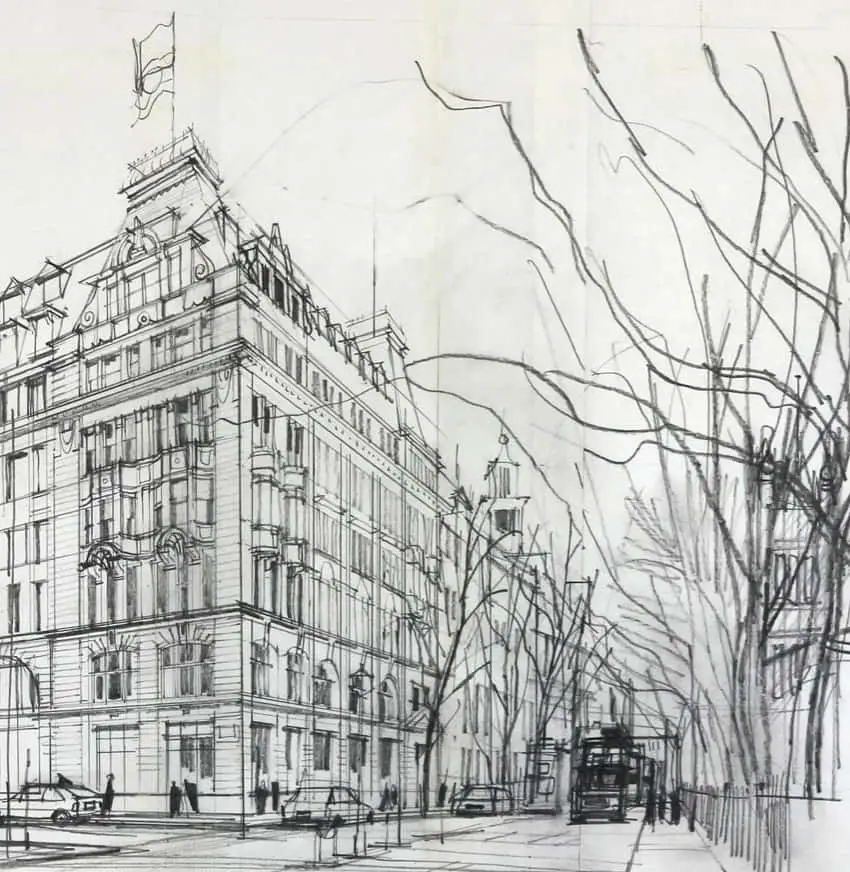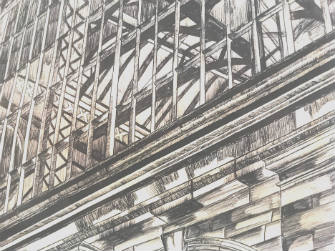Drawing on location can certainly be an enjoyable experience. It will take you out of your comfort zone and challenge your drawing abilities. Many people will be overcome by the sheer impact of a busy city center resulting in their inability to focus on a particular task.
When drawing on location, there are many things you will need to consider carefully. Do you want to create working sketches that can be taken back to the studio and developed further? Alternatively, as many artists do, they take photographs to recreate the hustle and bustle of the city environment.

It is essential that when drawing on locations in the city drawing on location are preparing yourself and have a clear idea of what you want to achieve. Use a sketchbook to gather ideas and inspiration quickly, and certainly don't overthink this part of the process. Take a small sketchbook. You can promptly add small sketches. Focus on shadows and reflections, especially buildings, reflective surfaces, cars, and tall skyscrapers—practice speed sketching.
- Location
- Consider your viewpoint very carefully.
- Equipment and materials list
- Simple City Sketching with a pencil
- Urban landscape drawing
- Drawing, Architecture, and Buildings
- How to draw skylines
How to Sketch on Location?
So what do we mean by ‘ Urban Landscape’? Any image which combines buildings and elements of a city or town can be defined as an urban landscape.
An urban setting concerning the sheer amount of detail, space, and atmosphere alone can offer incredible locations to draw and paint. A cityscape has the real advantage of being accessible to most people. Additionally, it can provide so much concerning interesting visual things to bring as its natural opposite. The best cityscapes convey the modern world with a real sense of visual vibrancy.
The Importance of Location
Before drawing on location, ensure you find a setting that will maintain your interest and enjoyment. Why do I consider the position important? Ask yourself a couple of questions. Having a clear idea of what it is they would like to draw.
Consider Your Vantage Point Carefully
Once I find a location, I don’t settle on the first choice. Look around carefully, see what attracts your eye, and consider the subject from some vantage point. Also,o consider your viewpoints very carefully. Do high angles interest you or the tops of buildings? Or is it the perspective of long, busy lit-up streets that inspires your creativity?
Remember that viewpoint is the position from which your eyes view the subject matter.
Make a List of Equipment
What equipment should you take when drawing on the location? A pencil and fine-line pen are great for capturing details quickly. As are graphite sticks for quickly adding tone. Take a small stool to sit on, park benches are not always handy when drawing, and comfort is essential.
A good idea to begin with is maybe a tiny sketching pad. This would give you the advantage of being able to sketch ideas quickly. A small watercolor tray and a water bottle are also good if you wish to add color to your drawings. Mobile devices or digital cameras are also useful for taking quick photographs, which can be returned to your studio and used for reference purposes.
The Art of Simple City Sketching!
Don't try to create a photo-realistic drawing on location. You won't have the time, plus it's impossible to draw every detail. Begin with speed sketching, trying to capture the vital essence of your subject.
The sketches I create here are invaluable and can be taken back to the studio as the stimulus for further work. I always remember to look at and observe as I sketch continually. This helps build my visual awareness.
Another good idea I use at this stage would be to use a viewfinder which will allow me to focus on visually interesting features around me. I focus on observing, which ensures that I train myself to look as much as I draw. Read my post, ‘Best Pencils: For Drawing, Shading, and Sketching‘.
I then begin to sketch with faint basic outlines and diagonals, remembering not to apply heavy marks at this stage.
Urban Landscape Sketching
Many different drawing techniques can be used to draw a location. Speed sketching in a notepad is the first choice for many artists. Additionally, if you use a sketchbook, you can make notes relating to the subject, time of the day, and material used for reference when you return to your studio.
A more creative approach to drawing, such as different hand drawings, can be utilized. This I've, and offers real freedom and produces a new quality of line that suits beautiful ornate architectural settings such as classical buildings.
Continuous line drawings are also a proven method that many professional artists use. Again, this will enable you to create an interest in quality online with your picture. A continuous line is ideally suited to a fine-line pen, adapted to pen and water. An exciting method that can offer some great results.
Timed drawings, again, similar to speed drawings, can offer a difference in the type of quality line.
Produce Tonal drawings with graphite. This is suited to the application of shade and tone. This is a viable drawing technique to create dramatic three-dimensional results from buildings and shadows.
Tell a Story Through Your Drawings
This is why your choice of location can become very personal. If you hold an attachment to a sense of place, then your drawings can convey the intimacy of memory. Another effective way of depicting the passing of time is to juxtapose the old with the new. Communicating the story of what went before and of time's gone by.
The juxtaposition of people in an environment is also an unusual source of ideas when drawing the Urban Landscape. When contrasted with the static charge and all vertical lines of buildings, the contrast between moving individuals is exciting and can be a real source for drawing.
Contrast. The natural environment and the man-made can offer exciting sources to draw from. For example, when contrasted with a modern building behind a park, a tree in a park can provide a real sense of contrast with the softness a natural form can offer. There are many opportunities within the urban landscape to find examples of natural and manmade environments.
How to Draw Architectural Styles
If your primary focus is to draw buildings on location, then it would probably be a good idea to research the different architectural styles before you begin drawing. Understanding the difference between Classical, Modern, and Postmodern architecture, we'll help us understand the various types of buildings in our modern cities.
Classic Style buildings include columns, decorative elements, and domed features or could be identified as part of the distinct tradition—these types of structures are exciting to draw and photograph, especially from dramatic vantage points with diagonal views.
A modern style is entirely different from the classic style of architecture. Modernist buildings fill our towns and cities. Box-Like structures and skyscrapers and prefabricated units. One particularly exciting feature of these buildings is how the reflective surfaces can create some subtle and interesting things to draw.
Postmodern architecture is a combination of classic and modern styles. Postmodern architects are known for creating and designing quirky designs. This has resulted in some very unique buildings which are attractive to draw.
Street Landscape Drawing Step by Step
Follow this simple step-by-step process to create a realistic skyline. For an in-depth outline on how to draw a city street, please read my post, ‘How to Draw a City Street'. Think about the form of the building you are trying to draw. Draw the outlines faintly and establish the main shapes in your drawing.
The next stage is to add depth of field to your drawing. This can be achieved by adding more details in the different sections of the picture. Split the page into 3 parts, foreground, midground, and background.
Begin to add tone and shade and shade, with the darker lines and shadows in the front and the lighter areas in the background sections. If will create the illusion of distance and space.
Final stages to add detail to your drawing by adding features such as windows, reflections, and doorway lights.
City Sketching Made Easy
If you are looking for an easy way to draw on location in the city, follow some of the tips outlined in this article. Establish a position and what you want to record draw. Begin speed sketching, use photographic aids and viewfinders and forget your equipment list before you set off. If you are looking for more information or tips on how to draw a landscape, please read my post, Tips for Drawing Landscape Vistas.

